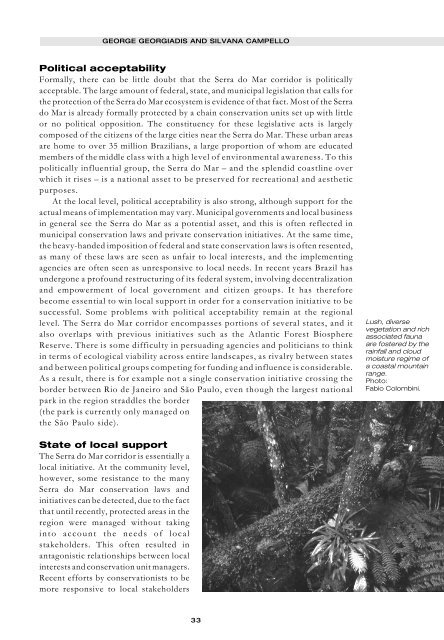Parks - IUCN
Parks - IUCN
Parks - IUCN
Create successful ePaper yourself
Turn your PDF publications into a flip-book with our unique Google optimized e-Paper software.
GEORGE GEORGIADIS AND SILVANA CAMPELLO<br />
Political acceptability<br />
Formally, there can be little doubt that the Serra do Mar corridor is politically<br />
acceptable. The large amount of federal, state, and municipal legislation that calls for<br />
the protection of the Serra do Mar ecosystem is evidence of that fact. Most of the Serra<br />
do Mar is already formally protected by a chain conservation units set up with little<br />
or no political opposition. The constituency for these legislative acts is largely<br />
composed of the citizens of the large cities near the Serra do Mar. These urban areas<br />
are home to over 35 million Brazilians, a large proportion of whom are educated<br />
members of the middle class with a high level of environmental awareness. To this<br />
politically influential group, the Serra do Mar – and the splendid coastline over<br />
which it rises – is a national asset to be preserved for recreational and aesthetic<br />
purposes.<br />
At the local level, political acceptability is also strong, although support for the<br />
actual means of implementation may vary. Municipal governments and local business<br />
in general see the Serra do Mar as a potential asset, and this is often reflected in<br />
municipal conservation laws and private conservation initiatives. At the same time,<br />
the heavy-handed imposition of federal and state conservation laws is often resented,<br />
as many of these laws are seen as unfair to local interests, and the implementing<br />
agencies are often seen as unresponsive to local needs. In recent years Brazil has<br />
undergone a profound restructuring of its federal system, involving decentralization<br />
and empowerment of local government and citizen groups. It has therefore<br />
become essential to win local support in order for a conservation initiative to be<br />
successful. Some problems with political acceptability remain at the regional<br />
level. The Serra do Mar corridor encompasses portions of several states, and it<br />
also overlaps with previous initiatives such as the Atlantic Forest Biosphere<br />
Reserve. There is some difficulty in persuading agencies and politicians to think<br />
in terms of ecological viability across entire landscapes, as rivalry between states<br />
and between political groups competing for funding and influence is considerable.<br />
As a result, there is for example not a single conservation initiative crossing the<br />
border between Rio de Janeiro and São Paulo, even though the largest national<br />
park in the region straddles the border<br />
(the park is currently only managed on<br />
the São Paulo side).<br />
State of local support<br />
The Serra do Mar corridor is essentially a<br />
local initiative. At the community level,<br />
however, some resistance to the many<br />
Serra do Mar conservation laws and<br />
initiatives can be detected, due to the fact<br />
that until recently, protected areas in the<br />
region were managed without taking<br />
into account the needs of local<br />
stakeholders. This often resulted in<br />
antagonistic relationships between local<br />
interests and conservation unit managers.<br />
Recent efforts by conservationists to be<br />
more responsive to local stakeholders<br />
33<br />
Lush, diverse<br />
vegetation and rich<br />
associated fauna<br />
are fostered by the<br />
rainfall and cloud<br />
moisture regime of<br />
a coastal mountain<br />
range.<br />
Photo:<br />
Fabio Colombini.

















